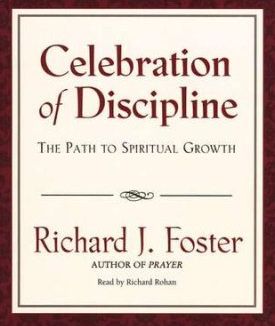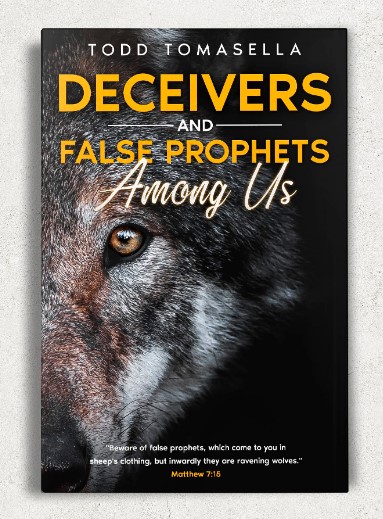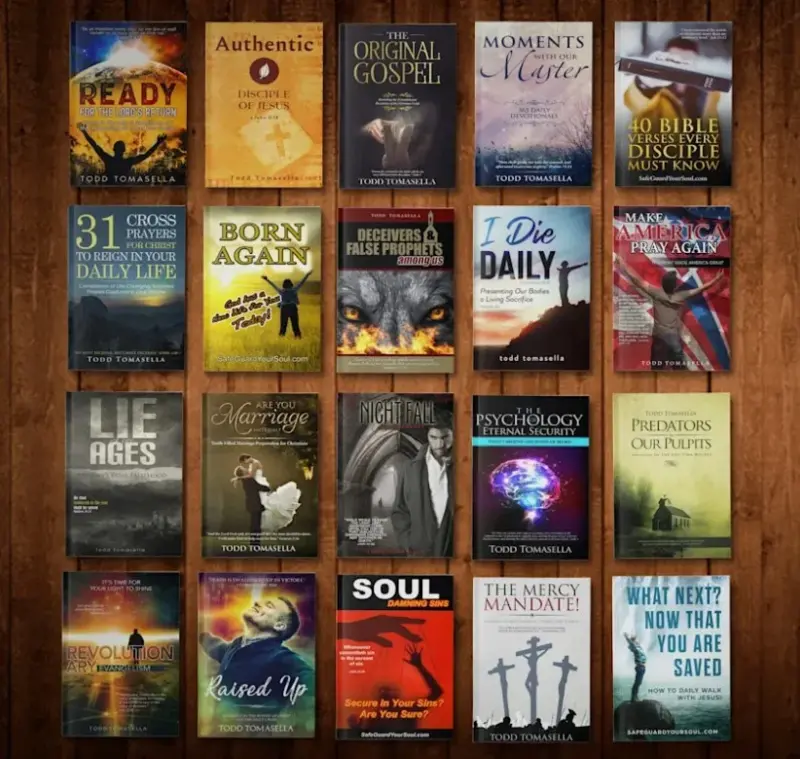A Biblically based commentary on current issues that impact you
Richard Foster—Celebration of Deception
by Bob DeWaay
 Christianity Today ran a glowing cover story about Evangelicalism’s recent embrace of medieval Roman Catholic mysticism entitled The Future lies in the Past.1 The article traced the beginning of the movement as follows: “The movement seems to have exploded in a 24-month period in 1977-1978, which saw the publication of Richard Foster’s bestselling Celebration of Discipline: The Path to Spiritual Growth and Robert Webber’s Common Roots: A Call to Evangelical Maturity.”2
Christianity Today ran a glowing cover story about Evangelicalism’s recent embrace of medieval Roman Catholic mysticism entitled The Future lies in the Past.1 The article traced the beginning of the movement as follows: “The movement seems to have exploded in a 24-month period in 1977-1978, which saw the publication of Richard Foster’s bestselling Celebration of Discipline: The Path to Spiritual Growth and Robert Webber’s Common Roots: A Call to Evangelical Maturity.”2
The article views Foster as one who continues to guide the movement: “From Dallas Willard, Richard Foster, and living practicing monks and nuns, they [those going back to Roman Catholic mysticism] must learn both the strengths and the limits of the historical ascetic disciplines.”3 So Foster was instrumental in starting a movement that is still growing 30-plus years later.
The irony about this particular CIC regarding Foster’s 1978 book is that in 1978 I myself was living in a Christian community committed to practicing much of what he promotes in Celebration of Discipline (even though we had not learned it from him directly). So I am not criticizing a practice about which I know nothing (or one in which I have no experience). I am criticizing a practice I foolishly allowed to deceive me for a significant portion of my early Christian life. When it comes to being deceived by mysticism, I have had abundant involvement. The only way I escaped it was through discovering and adopting the Reformation principle of sola scriptura.
In this article I will show that Foster’s “journey inward” is unbiblical and dangerous. I will show that most of the spiritual disciplines that he calls “means of grace” are no means of grace at all—but a means of putting oneself under spiritual deception.
The Journey Inward
The Bible nowhere describes an inward journey to explore the realm of the spirit. God chose to reveal the truth about spiritual reality through His ordained, Spirit-inspired, biblical writers. What is spiritual and not revealed by God is of the occult and, therefore, forbidden. We have discussed this in many articles and have produced DVD seminars on the topic. But the concept of sola scriptura is totally lost on mystics such as Richard Foster. They, like the enthusiasts that Calvin and Luther warned against, believe they can gain valid and useful knowledge of spiritual things through direct, personal inspiration.
Foster describes the idea of the disciplines that are the topic of his book: “The classical Disciplines of the spiritual life call us to move beyond surface living into the depths. They invite us to explore the inner caverns of the spiritual realm.”4 So Foster has conceptually repudiated sola scriptura on page one to replace it with a journey inward to explore the realm of spirits. Something must have been seriously amiss in evangelicalism already in 1978 to render this book a bestseller! It ought to have been repudiated on the spot. In a footnote to that statement Foster writes, “In one form or another all of the devotional masters have affirmed the necessity of the Disciplines” (Foster: 1). The devotional “masters,” by the way, are mostly Roman Catholics who never were committed to the principle of sola scriptura. It is not surprising that they looked for spirituality through experimentation. But as an “inner light” Quaker, Foster never was committed to sola scriptura either.
Forgetting that the Bible forbids divination, Foster explains what he is after:
[W]e must be willing to go down into the recreating silences, into the inner world of contemplation. In their writings, all of the masters of meditation strive to awaken us to the fact that the universe is much larger than we know, that there are vast unexplored inner regions that are just as real as the physical world we know so well. . . . They call us to the adventure, to be pioneers in this frontier of the Spirit. (Foster: 13)
Realizing that his readers would likely take this as an endorsement of Eastern religions, he makes a disclaimer that it is not Transcendental Meditation (TM) or something of that ilk: “Eastern meditation is an attempt to empty the mind; Christian meditation is an attempt to empty the mind in order to fill it” (Foster: 15). But what Foster wishes us to fill our minds with are personal revelations from the spirit realm that we naively are to think are the voice of God. This sort of meditation is not meditating on what God has said, but uses a technique to explore the spirit world. In other words, it is divination.
What we learn about the spirit realm either is revealed by God (once for all in Scripture) or gleaned by man-made techniques. That distinction is the difference between Christianity and paganism. Only Bible believers know what God has said about Himself and what He wishes to reveal about the unseen spirit world. Foster’s material continues to be popular because we live in an age where being spiritual pioneers on a journey into the unseen realm of the spirits is the essence of popular piety. It is the spirituality of secular talk shows.
To fully understand the degree of Foster’s deception, he even calls these techniques to the inner journey “means of grace”: “They [the Disciplines] are God’s means of grace” (Foster: 6). As with all who teach spiritual disciplines, there are no boundaries to these false “means.” For example, consider this recommended practice: “After you have gained some proficiency in centering down, add a five- to ten-minute meditation on some aspect of the creation. Choose something in the created order: tree, plant, bird, leaf, cloud, and each day ponder it carefully and prayerfully” (Foster 25). This after he had just taught breathing exercises (a means of “centering down”). Then he makes a startling claim: “We should not bypass this means of God’s grace” (Foster: 25). And there we have it: meditating of a leaf can be a means of grace!
Foster’s journey inward is to discover a spirit world that is available for any who search for it: “How then do we come to believe in a world of the spirit? Is it by blind faith? Not at all. The inner reality of the spiritual world is available to all who are willing to search for it” (Foster: 18). He claims that this spiritual search is analogous to scientific experimentation. Never mind that every pagan culture that has existed has believed in the “spiritual world.”
Spirituality of the Imagination
The Bible does not have anything good so say about the imagination. For example: “Thus says the Lord of hosts, ‘Do not listen to the words of the prophets who are prophesying to you. They are leading you into futility; They speak a vision of their own imagination, Not from the mouth of the Lord'” (Jeremiah 23:16). A search of the KJV for “imagination” yields 14 verses, and in each case it is a bad thing. According to the Bible, the imagination is where people go when they do not want to listen to God.
However, for Foster the imagination is central: “The inner world of meditation is most easily entered through the door of the imagination. We fail today to appreciate its tremendous power. The imagination is stronger than conceptual thought and stronger than the will” (Foster: 22). Some of the authorities he cites on this point are C. G. Jung, Ignatius of Loyola, and Morton Kelsey. Jung is famous for his concept of the collective unconscious, and Kelsey was an Episcopal priest committed to Jungian principles. Kelsey wrote many books promoting mysticism. The advice Foster gleans from these teachers is that we must learn to think in images and take our dreams to be a possible doorway into the spirit world. Foster claims that dreams are something we already have and can help us develop the use of the imagination. He says, “Keeping a journal of our dreams is a way of taking them seriously” (Foster: 23).
There is, Foster warns, a danger to this process: “At the same time [that we ask for dreams to be God speaking to us], it is wise to pray a prayer of protection, since to open ourselves to spiritual influence can be dangerous as well as profitable” (Foster: 23). I would say that is asking God to protect us as we use various techniques to go where He does not want us to go (into the world of the spirits to gain information). The danger he warns of is far greater than Foster imagines. Those who take the journey inward will be deceived—every time! We are not equipped to gain spiritual information from that realm. That is why God speaks to us through His ordained mediators (the inspired Biblical writers); otherwise we would be fishing in the dark in a medium we are not suited for.
Foster teaches his readers to use their imaginations to experience Biblical stories with the five physical senses. Here is what he claims will happen:
As you enter the story, not as a passive observer but as an active participant, remember that since Jesus lives in the Eternal Now and is not bound by time, this event in the past is a living present-tense experience for Him. Hence, you can actually encounter the living Christ in the event, be addressed by His voice and be touched by His healing power. It can be more than an exercise of the imagination; it can be a genuine confrontation. Jesus Christ will actually come to you. (Foster: 26)
Showing that Foster’s ideas are still influential in our day, Greg Boyd cites some of Foster’s words here to support what he calls “cataphatic prayer” which uses the imagination and images as a means to contact God and gain spiritual information.5 Those who endorse this practice assume they are not being deceived by spirits, but I cannot see on what grounds.
Foster prescribes a practice using one’s imagination that mimics astral projection to the degree that he actually includes a footnote disclaimer stating that it is not astral projection (Foster 28). It begins by telling his readers to imagine themselves going out into nature into a beautiful place (Boyd describes how he practices this, as well as its results6). After enjoying the sights and smells (in your imagination) these are the next steps:
In your imagination allow your spiritual body, shining with light, to rise out of your physical body. Look back so that you can see yourself lying in the grass and reassure your body that you will return momentarily. Imagine your spiritual self, alive and vibrant, rising up through the clouds and into the stratosphere. . . Go deeper and deeper into outer space until there is nothing except the warm presence of the eternal Creator. Rest in His presence. Listen quietly, anticipating the unanticipated. Note carefully any instruction given. With time and experience you will be able to distinguish readily between mere human thought that may bubble up to the conscious mind and the True Spirit which inwardly moves upon the heart. (Foster: 27, 28)
I must ask how one knows whether “True Spirit” is not a deceiving one? Mysticism’s fatal flaw is that it naively assumes that Christians having subjective religious experiences must therefore be having Christian experiences that are truly from God—even if the experiences were provoked through unbiblical practices similar to those used by pagans.
Mental Alchemy
Foster’s approach to prayer is laced with mysticism as well. He claims that prayer needs to be learned from people who have the right experiences and are “masters” who know what they are doing. Foster does not teach ordinary prayer, whereby we bring our needs and requests to the Lord and know that He hears us (because He promised that He does). Here is why he thinks such prayer fails:
Often people will pray and pray with all the faith in the world, but nothing happens. Naturally, they were not contacting the channel. We begin praying for others by first centering down and listening to the quiet thunder of the Lord of hosts. Attuning ourselves to divine breathings is spiritual work, but without it our praying is vain repetition (Mt. 6:7). Listening to the Lord is the first thing, the second thing, and the third thing necessary for successful intercession. (Foster: 34)
Of course this means we have to become mystics if we want to pray.
He teaches that we first must hear personal revelations from God, using meditation techniques such as he teaches, before we pray. He says: “The beginning point, then, in learning to pray for others is to listen for guidance . . . This inner “yes” is the divine authorization for you to pray for the person or situation” (Foster: 35). No! Foster is wrong! The only authorization we need to pray is the Biblical command to pray—not personal revelations.
For Foster, meditation (mystical style) is necessary but not sufficient. He also brings the imagination into the process: “As with meditation, the imagination is a powerful tool in the work of prayer” (Foster: 36). He credits Agnes Sanford7 for helping him see the value of using the imagination in praying. Foster writes, “Imagination opens the door to faith. If we can ‘see’ in our mind’s eye a shattered marriage whole or a sick person well, it is only a short step to believing it will be so” (Foster: 36). Sanford got her ideas from Theosophy, New Thought, Jung, and Emmet Fox. These ideas, echoed by Foster, come from the unbiblical “mind over matter” thinking of that era. That kind of thinking uses creative visualization to change reality or channel spiritual power. Foster suggests, “Imagine the light of Christ flowing through your hands and healing every emotional trauma and hurt feeling your child experienced that day” (Foster: 39).
In his 1985 book, The Seduction of Christianity, Dave Hunt labeled creative visualization such as what Foster promotes, “mental alchemy.”8 Hunt warned the church that Foster promoted such mental alchemy in Celebration of Discipline, and as we have shown, he, in fact, does. So how is it that 24 years after Hunt’s warning Foster is more popular than ever with Evangelicals? The answer is end times deception. Now, a huge movement that claims to be a reformation promoting Foster, Willard and their versions of mysticism does exist (i.e., The Emergent Church). Things have gotten so very much worse.
Spiritual Directors
Once mysticism and the supposed need to gain personal revelations from God are embraced, there arises a need for new “masters” who are better at navigating the spirit world. Pagan societies have always had such persons. They are called “shamans.” Eastern religion calls them “gurus.” Deceived Christians call them “spiritual directors.” Foster explains, “In the Middle Ages not even the greatest saints attempted the depths of the inward journey without the help of a spiritual director” (Foster: 159). The problem, according to Foster, is that the churches (in 1978) lacked “living masters”:
No doubt part of the surge of interest in Eastern meditation is because the churches have abrogated the field. How depressing for a university student, seeking to know the Christian teaching on meditation, to discover that there are so few living masters of contemplative prayer and that nearly all of the serious writings on the subject are seven or more centuries old. No wonder he or she turns to Zen, Yoga, or TM. (Foster: 14)
Foster’s dream has come true. Today people can even practice Yoga in a Christian church. We have Christian TM; it is called contemplative prayer. Yes, Eastern religion has come right into the church, and Foster has helped usher it in.
But what about “living masters” or spiritual directors? In 1972 Morton Kelsey lamented their lack: “Indeed I would suggest that everyone who is serious about relating to the spiritual realm find himself a spiritual director, if there were more men trained and experienced in this way.”9 That “problem” has been solved in a huge way. Evangelical theology schools are now offering masters degrees in “spiritual formation” in order to equip people to be “spiritual directors.” Here is what Biola University says about its program: “This degree is designed to equip men and women for the ministry of spiritual direction, discipleship, formation and soul care in the local church and for further academic training in spiritual formation.”10 Spiritual Directors International will help you find a spiritual director regardless of your religion.11 Richard Foster’s own Renovare, which purports to “encourage renewal in the Christian church,” has a list of spiritual direction programs.12
Foster explains the purpose of the spiritual director: “He is the means of God to open the path to the inward teaching of the Holy Spirit” (Foster: 160). Apparently, in a full-blown rejection of sola scriptura where the Holy Spirit’s teaching is mediated to the church through the Biblical writers only, we need mediators for personal revelations beyond scripture.
Foster explains how spiritual directors lead: “He leads only by the force of his own personal holiness” (Foster: 160). In Roman Catholicism the Pope is called “his holiness” and in Tibetan Buddhism the Dalai Lama is called “his holiness” but now evangelicals are developing a class of people who evidently deserve the title. How exactly are we to judge when someone has gained “personal holiness” sufficient to be a spiritual director and mediate spirituality to others? Foster says, “Though the director has obviously advanced further into the inner depths, the two [master and disciple] are together learning and growing in the realm of the Spirit” (Foster: 160). Foster cites Roman Catholic mystic Thomas Merton about how this works: “The spiritual director was something of a ‘spiritual father who begot the perfect life in the soul of his disciple by his instructions first of all, but also by his prayer, his sanctity and his example. He was . . . a kind of ‘sacrament’ of the Lord’s presence in the ecclesiastical community” (Foster: 161).
End Times Delusion
When it comes to end times deception, Foster is on the cutting edge of embracing it. Consider what he wrote: “In our day heaven and earth are on tiptoe waiting for the emerging of a Spirit-led, Spirit-intoxicated, Spirit-empowered people. . . . Individuals can be found here and there whose hearts burn with divine fire” (Foster: 150). Such inclinations have led to massive deception. They smack of the Latter Rain deception, now embodied in such false teachers as Rick Joyner and Mike Bickle. They are elitist. They are in line with the beliefs of the Emergent Church as well. He also says: “Our century has yet to see the breaking forth of the apostolic church of the Spirit” (Foster: 150). Now we have the New Apostolic Reformation claiming to be just that. Foster’s ideas now embody the massive apostasy and end times deception that characterize our age.
Foster’s teachings have taken the church as far away from the Reformation principle of sola scriptura as the Roman Catholic Church ever was. The only thing left is for them to bring us all the way back to Rome. Christianity Today praises Foster for pointing us in that direction.
In early 2008 I wrote a CIC article about how abandoning the principle of sola scriptura would lead evangelicals back to Rome.13 It was partly a response to the CT article praising mysticism. The response I received was rather unexpected. I was contacted by former evangelicals who had rejected sola scriptura and had gone back to Rome! They wanted to debate me about sola scriptura. Sadly, my point was proven. As a response to their misguided challenge our church hosted a seminar on sola scriptura, called Faith at Risk 4.14 In the seminar Gary Gilley and I defended the scriptures as the sole authority for the church.
The aforementioned CT article discusses a new monasticism, former evangelical leaders converting to Roman Catholicism, and mystical practices like lectio divina—and they call all of it a good and hopeful thing. Chris Armstrong, the author of the article, concluded, “That they [evangelicals] are receiving good guidance on this road from wise teachers [Foster and Willard] is reason to believe that Christ is guiding the process. And that they are meeting and learning from fellow Christians in the other two great confessions, Roman Catholicism and Eastern Orthodox, is reason to rejoice in the power of love.”15
Who is left to defend the principles of the Reformation? One would think Reformed theologians are, but they aren’t doing their job. In the last CIC article we mentioned Reformed theologian Donald Whitney who wrote: “Richard Foster’s Celebration of Discipline has been the most popular book on the subject of the Spiritual Disciplines in the last half of the twentieth century. The great contribution of this work is the reminder that the Spiritual Disciplines, which many see as restrictive and binding, are actually means to spiritual freedom.”16 That from a teacher in a Reformed seminary?
If a book that teaches Christian TM, Christian astral projection and mental alchemy by means of the imagination is a “great contribution,” then something is seriously wrong here. The delusion is so widespread that I see no other explanation for it than the end time deception predicted by Paul: “But the Spirit explicitly says that in later times some will fall away from the faith, paying attention to deceitful spirits and doctrines of demons,” (1Timothy 4:1). Another passage warns: “For the time will come when they will not endure sound doctrine; but wanting to have their ears tickled, they will accumulate for themselves teachers in accordance to their own desires, and will turn away their ears from the truth and will turn aside to myths” (2Timothy 4:3, 4).
That time now is here. We are accountable to God for what we believe and practice. Those who wish to persevere in the faith in this age of delusion must base their beliefs and practices only on the truths found in Scripture. Foster’s journey into the world of the spirits will deceive all who enter it.
Issue 112 – May / June 2009
End Notes
-
- Chris Armstrong, “The Future lies in the Past” in Christianity Today, February 2008.
- Ibid. 24.
- Ibid. 29.
- Richard Foster, Celebration of Discipline: The Path to Spiritual Growth (New York: Harper & Row, 1978) 1. All subsequent citations from this book will be bracketed within the text in this fashion: (Foster: 1).
- Greg Boyd, Seeing is Believing, (Grand Rapids: Baker, 2004). Boyd cites Foster to prove that the Lord will actually come to us through our use of “imaginative meditation.” I deal with this issue more fully in CIC issue 83 July/August, 2003: HTTP://CICMINISTRY.ORG/COMMENTARY/ISSUE83.HTM
- Ibid. 111-125.
- I write about Sanford’s inner healing theories in CIC Issue 96: HTTP://CICMINISTRY.ORG/COMMENTARY/ISSUE96.HTM
- Dave Hunt and T. A. McMahon, The Seduction of Christianity (Eugene: Harvest House, 1985) 138.
- Morton Kelsey, Encounter With God, (Bethany Fellowship: Minneapolis, 1972) 179.
- http://www.biola.edu/spiritualformation/programs/ SEE PDF
- HTTP://WWW.SDIWORLD.ORG
- HTTP://WWW.RENOVARE.ORG/JOURNEY_TRAINING_DIRECTION.HTM
- CIC Issue 105; March/April 2008: HTTP://CICMINISTRY.ORG/COMMENTARY/ISSUE105.HTM
- Watch this seminar HERE
- Armstrong, Future
- DONALD S. WHITNEY, SPIRITUAL DISCIPLINES FOR THE CHRISTIAN LIFE (COLORADO SPRINGS: NAVPRESS, 1991) 23.
Support | STORE | Podcasts | Jail/Prison Ministry | Mexico Mission here | All Ministry Updates | More on Assurance here | Because You Care Page | The Greatest of these is Charity | Be Ready in the Morning [podcast] | The Sure Mercies of David [podcast] | That Repentance and Remission of Sins should be Preached [podcast] | At His Feet | Knowing God | The Cross Life | 100’s of Christ-centered Scripture-rich Podcasts | Christology = the Study of Christ


Apostasy
BEWARE of the Wolf Defenders [podcast]

A DANGEROUS BREED OF HYPOCRITE!
Truth-Despising, Wolf-Worshiping,
Devil-Defending Agents of Satan who Think they are Saved (think again!)
Walking in God’s love can never be separated from walking in God’s truth! They are divinely, eternally married! Don’t you dare claim to be walking in God’s love if you are not speaking God’s truth (Ephesians 4:15; Proverbs 27:5-6).
The true man of God fears God and therefore fears no man. He will speak the truth no matter what the cost.
“When you want to help people, you tell them the truth. When you want to help yourself, you tell them what they want to hear.” Thomas Sowell
MORAL cowards are self-serving and deceitful. When THEY want something to be true, they ignore God’s Word and want to argue to defend their position instead of dying to self and believing and living by the WORD of God. Repent sinner. “Let God be true and EVERY man a liar” (Romans 3:4).
Jesus says, “Ye are they which justify yourselves before men; but God knoweth your hearts: for that which is highly esteemed among men is abomination in the sight of God” (Luke 16:15).
If you seek to justify sinners against the counsel of God’s Word, you are not a man of truth but rather a self-serving moral coward who seeks to justify sinners instead of loving them enough to give them the truth so they can be saved. Repent sinner.
“He that justifieth the wicked, and he that condemneth the just, even they both are abomination to the LORD.” Proverbs 17:15
Judge not those who “judge righteous judgment”! (John 7:24)
“Today’s church cannot remain faithful if it tolerates false teachers and leaves their teachings uncorrected and unconfronted.” Albert Mohler
The JUDGE has spoken in a book called THE BIBLE. He’s calling us to pay attention when we read it. His written WORD records for us HIS judgments – the judgments of the Judge. So, the lame misuse of the “judge not” scripture is a cover up from novices to justify their worship of wolves who feed their flesh nature instead of telling them God requires them to live the crucified life (Matthew 7:1-5; Philippians 3:18-19; 2 Timothy 4:2-4; 2 Peter 2:1-3; 2 John 10-11, etc.).
Jesus says “Judge righteous judgment” and the only way to do that is call the shots like He does in His written Word – beginning with our own lives and out from there (John 7:24). YES GOD is the Judge and THE JUDGE HAS SPOKEN His judgments in the 66 glorious books in the canon of His Word. So there are no excuses. We shall be judged by His Word, the Bible (John 12:48; Romans 2:16; Revelation 20:10-15).
“The word that I have spoken, the same shall judge him in the last day.” John 12:48
YES, God is the Judge and THE JUDGE HAS SPOKEN – it’s called the BIBLE. We have HIS judgments on record in the Bible. Now let’s repent and cease the smokescreens to evade truly repenting! See John 3:19-21.
ATTENTION: The LORD calls His people to mark and to expose His enemies and not defend or support them! Those who prop up, support, follow, and defend the obvious wolves operating among the professing church only do so due to their own refusal to study to show themselves approved before a holy God (2 Timothy 2:15). It’s time to get immersed in the Word!
WARNING: YOU’D BETTER MAKE SURE YOU AREN’T COVERING FOR AND DEFENDING ONE OF THE “MANY FALSE PROPHETS” JESUS REPEATEDLY WARNED US TO “BEWARE OF” (Matthew 7:15; 24:11, 24, etc.). IF YOU DO, YOU WILL GO TO HELL WITH THEM!
Isn’t it so hypocritically interesting how those who misuse Jesus’ word “Judge not” and how they don’t think twice to condemn you for supposedly condemning others? So, they are telling you not to judge (out of context) while they openly judge you. SMH at these blinded hypocrites. In Matthew 7:1-5 Jesus was speaking of hypocritical judgment, not all judgment! Stop taking Jesus’ words out of context!
The kingdom of God is not dictated by any mere human’s emotions or notions. Let’s live by God’s Word saints.
LIKE IT OR NOT, it is the divine mandate and duty of the members of Christ’s body to “earnestly contend for the faith once delivered to the saints” against “ungodly men” who are false teachers. Read Jude 3-4. The divine mandate to mark false teachers is none of your business or mine! God didn’t ask you before He spoke and commanded that these things be done. This kingdom of God is not relegated to you or me, nor our flimsy musings. We live by God’s Word and not someone’s emotions or un-sanctified whims (Colossians 2:8). Do we not understand that God wants to protect His sheep? The kingdom of God is about KING JESUS, not you! It’s time to die to self!
SUPPORTING WOLVES (Christ’s very subverting enemies) will land you in hell with them according to God’s Word.
Those who try to shut down warnings are simply afraid they are the next ones to be exposed! Repent! John 3:19-21
Counterfeits defend their wolves while true remnant disciples of Jesus are “set for the defence of the gospel” as was Paul the apostle (Philippians 1:17).
Tina McGovern writes:
“It is astounding and amazes me every time people defend these actions and condemn the actions of the righteous who hold to the truth clearly brought forward in Scriptures. But…as we know…it takes false followers to follow false teachers and false prophets…all in hopes of being extravagantly rich to spend it on their lusts. It’s like manipulating the mind to feel free to lust guiltlessly. Dear Lord, You alone know who are Yours. In your great mercy make a way where there appears to be no way, to deliver those who are deceived and fallen captive to the deceiver. Deliver them to the uttermost.”
JOIN THE CHORUS with the remnant of Christ’s elect … by openly shining the light of truth on the false teachings and teachers of our day who are being used of Satan to lead millions to eternal damnation (Isaiah 9:16; Matthew 15:14). This is not a game! The apostle Paul said he was “set for the defence of the gospel” and Jude mandated that we “earnestly contend for the faith once delivered to the saints” against “ungodly men” (Philippians 1:17; Jude 3-4). When we look at what the whole of Scripture tells us about wolves among us and their mission (steal, kill, destroy), we may see a different picture. We will see them as the very agents of Satan we are told they are (2 Corinthians 11:12-15). The books Deceivers and False Prophets Among Us and Predators in Our Pulpits were written to showcase a myriad of shunned and purposely neglected Bible verses about wolves and their characteristics and methods.
The “Great Shepherd of the sheep” (Heb. 13:20) fully intends to protect the sheep He died for and part of that protection comes from His body/watchmen’s warnings. “Warn them from me” (Ezekiel 3:7).
THE LORD’S WATCHMEN are on their posts and doing exactly what they are supposed to be doing – warning. “So thou, O son of man, I have set thee a watchman unto the house of Israel; therefore thou shalt hear the word at my mouth, and warn them from me.” (Ezekiel 33:7)
In fact, if the watchman doesn’t sound the alarm, warning of danger, he is guilty before God.
“But if the watchman see the sword come, and blow not the trumpet, and the people be not warned; if the sword come, and take any person from among them, he is taken away in his iniquity; but his blood will I require at the watchman’s hand.” Ezekiel 33:6
Ernie Collins writes:
“WOE UNTO THE FOOLISH WHO CONTINUE TO BE DECEIVED WITH GREAT DECEPTION OF FALSE TEACHERS AND PREACHERS; FOR THEY WILL SURELY FACE THE GREAT JUDGMENT AND WRATH WITH THE LAKE OF FIRE FOR THEIR FOOLISHNESS. A DIRE WARNING WITH GREAT CONSEQUENCES FOR ALL FALSE TEACHERS AND PREACHERS: JEREMIAH 23:1-2 (KJV) AUTHORIZED EDITION BIBLE:
1: WOE BE UNTO THE PASTORS THAT DESTROY AND SCATTER THE SHEEP OF MY PASTURE! SAITH THE LORD.
2: THEREFORE THUS SAITH THE LORD GOD OF ISRAEL AGAINST THE PASTORS THAT FEED MY PEOPLE; YE HAVE SCATTERED MY FLOCK, AND DRIVEN THEM AWAY, AND HAVE NOT VISITED THEM: BEHOLD, I WILL VISIT UPON YOU THE EVIL OF YOUR DOINGS, SAITH THE LORD.” ERNIE COLLINS
The LORD told us that He is “not willing that any should perish, but that all should come to repentance” (2 Peter 3:9). Yet, He will not save any person who freely chooses to give ear to, to support, to fund, and/or defend His enemies (2 Chronicles 19:2; 2 John 7-11, etc.). Such is high treason.
Does Satan have agents? Yes (2 Cor. 11:12-15). And, who would want to defend those emissaries except those who are also Satan’s agents? JUST WHO would want Satan’s emissaries to continue to mislead people? Who? Who other than those who are also Satan’s property due to their unrepentant hearts? Do you recall how Satan entered into one of Jesus’ own twelve? See John 13:27.
So who can prove by Scripture or even common sense that protection via warning is a sin? Who can show that it’s God’s mandate and His will for His body to do?
“Judge righteous judgment” (John 7:24). When you attack someone for judging, you are judging them. If there is no judgment/discernment, why are you judging someone for judging? You are doing exactly what you are accusing them of doing (Romans 2:1-3). Jesus says: “Ye shall know (Gr. discern) them BY THEIR FRUITS” (Matthew 7:16, 20).
Charles Kennon writes:
“‘Judge Not’…One of the most misunderstood and improperly applied verses in the Bible. Few read the entirety of this portion of Scripture thus understanding that Jesus was not condemning righteous judgment but rather rebuking men for hypocritical judgment.
Be not deceived my friend, WE ALL JUDGE…The question is this; By what STANDARD do we Judge? By God’s Word or by what seems right to US. Here is a touchstone by which you can examine yourself. Those who are of God employ the phrase ‘Judge not’ in a DIDACTIC manner to properly instruct others in the way (Matthew 7:1-5). Those who are not of God employ ‘Judge not’ in a DEFENSIVE manner to evade the truth and justify themselves when the light of God’s Word uncovers or confronts them in their sin (Genesis 19:9).”
Jesus says “Judge righteous judgment” (John 7:24). Paul wrote “do not ye judge them that are within?” (1 Corinthians 5:12).
MESSAGE RECEIVED:
“God is the only one can judge everyone. He will judge you also guys. Be careful of what you are saying. Anyway your judgment isn’t going to change anything. It conveys hatred and not Christian love. We will be judged with the same measure.”
RESPONSE:
1. Is God the Judge? Yes or no? 2. Did God, the Judge, speak? Do you know about the Book called the Holy Bible? THAT is God’s judgments and He, the Judge, told us that all idolaters are going to hell (Rev 21:8). All who reject Christ for their religion, like Teresa, are not forgiven and going to hell. The Judge has spoken – from Genesis to Revelation. It’s time to repent, fast and pray, until you fear no one except the LORD. At that point He will grant you a fearlessness to preach His Word, regardless of how mere sinful men respond (Is. 51:7, 12; Gal. 1:10). This person you are defending is a sinful woman who refused to repent and be saved by the grace of God through Christ alone. She promoted an antichrist, works-based religion her whole life. The Bible assures us that every false teacher will have eternal “damnation” (2 Peter 2:1-3.) You have no clue what love is. You going to call JESUS CHRIST unloving for openly lambasting the false leaders of His day and telling them they were going to hell? Read Matt 23. Repent. “Open rebuke is better than secret love. 6 Faithful are the wounds of a friend; but the kisses of an enemy are deceitful” (Proverbs 27:5-6). You are in direct disobedience to the LORD by not earnestly contending against His enemies and marking and exposing them (Rom. 16:17-18; Ephesians 5:11; Jude 3-4, etc.). Repent and follow Jesus by exposing false leaders! (Matt, 23, etc.). While feigning to love Jesus, you are defending one of the false prophets He repeatedly warned us about who spent her life leading precious souls away from Him and into eternal hell. Repent.
Since when is warning Christ’s sheep of the devouring wolves hateful? Since when is such judgmental? It’s only wrong in the eyes of those who are biblically illiterate. They have time to watch TV, listen to clowns like Osteen, etc. and no time to diligently study God’s Word. “Study to shew thyself approved unto God, a workman that needeth not to be ashamed, rightly dividing the word of truth” (2 Timothy 2:15). DO YOU warn your children when they are young to stay away from the street? Yes. Why? TO PROTECT THEM. How hateful would you be NOT to teach them to stay clear of danger?
So, are you saying the apostle Paul was being unloving and judgmental when he said this to a false prophet? – “And said, O full of all subtilty and all mischief, thou child of the devil, thou enemy of all righteousness, wilt thou not cease to pervert the right ways of the Lord?” (Acts 13:10).
You are attempting to selfishly protect and defend those who have told you everything’s okay without repenting (tickled your ears while flattering your flesh). They make you feel good now but you will hurt forever unless you truly repent and lay down your life and truly follow Christ – become HIS disciple. When you do, you will forsake the false Christs and idols.
As the Holy Ghost foretold, false prophets in this late hour are very popular because most would rather listen to feel good, tell-me-what-I-want-to-hear stories than “endure (hold themselves accountable to) sound doctrine.” But rather are “turned unto fables” which are feel-good, it’s all about ME stories (2 Timothy 4:2-4).
“WHO HATH BEWITCHED YOU? THE LORD SAYS COME LET US REASON TOGETHER.CHOOSE THIS DAY WHOM YOU WILL SERVE. TRUTH CUTS AWAY AT THE FLESH, YES THE FLESH AND GUESS WHAT? IT HURTS NOW DOESN’T IT? BUT SHALL WE PLEASE MAN?(GOD FORBID) OR GOD? THIS IS THE PROBLEM WITH ALL THESE APOSTATES, THEY DELIVER A SELF SERVING, GOOD FEELING, EAR TICKING, DOCTRINE OF DEVILS! JESUS CHRIST SAID TO DENY OURSELVES AND PICK UP OUR CROSSES AND FOLLOW HIM.NOT MAN! BUT THIS IS PRECISELY WHAT THEY PREACH, NOT TO READ THE WORD AND NOT REPENTANCE AND NOT BAPTISM OF THE HOLY GHOST. O GOD, FORGIVE THEM THAT REFUSE YOUR TRUTH, WE KNOW YOU WARN US OF THE STRONG DELUSION SENT FORTH BY YOU, THAT THEY SHOULD BELIEVE A LIE, BUT FATHER, FOR THE GLORY OF JESUS CHRIST, AND THE LOVE HE HAS FOR HIS BRIDE, GIVE THEM EARS LORD! GIVE THEM EYES!IN YOUR PRECIOUS AND MIGHTY NAME – THE NAME OF JESUS – WE PRAY! AMEN! I SAID AMEN!” SHANNON COOK
If you are defending wolves, you have no clue of true, New Testament Christianity because you have not truly laid down your life (repented, which is essential to salvation) and have therefore followed the voice of the enemy of all souls who is speaking through his false prophets (2 Corinthians 11:12-15). And, what we are seeing in this very post is God’s merciful attempt to get you to see that you are not following Christ and are in need of true repentance.
Those who defend Christ’s wolves are quite hypocritical actually. Isn’t it amazing how some people who come out of the woodwork to judge me/us for obeying God by identifying His enemies, are telling me/us we’re being judgmental? So, let’s get this straight – they freely judge and condemn those who warn the flock of God while saying we’re wrongly judging others by exposing those others to be Satan’s wolves. Wow! Can anyone spell “h-y-p-o-s-c-i-s-y”? Oh and not one of those who condemn and who are judging us have ever once said anything good about a post. Wow. No edification or agreement with truth, only condemnation for exposing their favorite wolf they have formed a soul-tie with instead of forming an intimate, abiding relationship with the One they claim to be serving (John 15:1-6).
“Therefore thou art inexcusable, O man, whosoever thou art that judgest: for wherein thou judgest another, thou condemnest thyself; for thou that judgest doest the same things. 2 But we are sure that the judgment of God is according to truth against them which commit such things.” Romans 2:1-2
You want to see vicious hatred? Just watch when wolves are uncovered by divine truth via Christ’s true, obedient remnant. Oh yes, you are going to see some of the vilest hatred you have ever seen from the defenders and supporters of those enemies of Christ. On this note, Shannon Cook writes:
“BELOVED BRIDE OF CHRIST, DEVILS COME BACK IN FULL FORCE TO DEFEND THEIR WOLF, THIS IS TO BE EXPECTED. THEY DESPISE TRUTH AND EXPOSURE OF LIES.”
Mark Herridge writes:
“The whole ‘judge not’ philosophy that has entered into the modern church has served to take the church further down the road of apostasy. It is a dangerous thing when we are told that we cannot use the Bible to judge matters concerning the church, the leadership of the church, or even those that claim to be a part of the church. It is certainly a fallacy to believe that we cannot compare people to the Word of God to determine what type of person they are. No sane person would allow a stranger to babysit their children without a background check and references, or in other words they are going to judge that person by some type of standard before placing their children’s lives in their hands. Everything should be judged by the Word of God, and it is absolutely biblical for us to do so.”
Those who aren’t warning the flock are not protecting the flock and are exposed as wolves themselves (Colossians 1:28).
Hell hath seen not fury like the scorn of a gullible follower of a wolf. They will lash out with pure hatred and malice while condemning you for daring to expose the wolf who is tickling their ear (2 Timothy 4:3). I make no apology for this “controversy.” Actually, this is exactly what we are told will happen when we discern –
“And they (true pastoral watchmen) shall teach my people the difference between the holy and profane, and cause them to DISCERN (distinguish) between the unclean and the clean. 24 And in controversy they shall stand in judgment; and they shall judge it according to my judgments: and they shall keep my laws and my statutes in all mine assemblies; and they shall hallow my sabbaths.” Ezekiel 44:23-24
“BUT YOU’RE NOT THE JUDGE” CRIES THE NOW EXPOSED WOLF-SUPPORTER. YES, THE LORD IS THE ULTIMATE JUDGE. AND GOD WILL JUDGE FOR SURE AND HE WILL JUDGE US FOR OBEYING OR NOT OBEYING HIS WORD WHICH INSTRUCTS US TO EXPOSE HIS ENEMIES IN ORDER TO PROTECT HIS SHEEP. YOU HAVE A PROBLEM WITH THAT?
It’s called discernment and judging righteous judgment (Ezekiel 44:23-24; John 7:24; 1 Corinthians 5:11-13, etc.). This doesn’t mean recklessly condemning anyone but it does mean discerning and pointing out false teachers whom Paul says are “accursed” (Galatians 1:6-9).
Saints, this whole thing of counterfeits balking about their favorite wolves being exposed for who they really are simply underscores the need to obey God by “earnestly contending for faith,” the original Gospel, revealed to us in the Holy Scriptures (Jude 3-4).
It seems like those who don’t want false prophets exposed (and so they defend them) are the ones who love the lies they have been told by those wolves. Isn’t this exactly what the LORD is saying through His prophet Jeremiah when he had him write that “My people LOVE to have it so” (Jeremiah 5:31; 2 Timothy 4:3). This would be biblical actually. Look at what the people who had once served God were saying to their leaders in Isaiah’s day:
“That this is a rebellious people, lying children, children that will not hear the law of the LORD: 10 Which say to the seers (leaders), See not; and to the prophets (leaders), Prophesy not unto us right things, speak unto us smooth things, prophesy deceits: 11 Get you out of the way, turn aside out of the path, cause the Holy One of Israel to cease from before us.” Isaiah 30:9-11
As it was in the prophet Isaiah’s day so it is today. It is “a rebellious people” who love lies and despise the law/Word of God and so by their attitudes and actions say “Don’t go overboard with all this Christian stuff. Going to church is good enough. Give us smooth, deceitful things! Continue to be enemies of the cross of Christ (Philippians 3:18-19)! We don’t want to be part of dying to self so Christ can reign in our daily lives! We just want Heaven but refuse to be bothered and inconvenienced with obedience to what Jesus instructed! We ‘love’ Him only inasmuch as we believe He’s going to get us out of hell!”
Wolves are identified as those who oblige this self-loving, self-serving, pleasure-loving last day generation of those who do have a “form (outward appearance) of godliness” and yet deny the power or authority of Christ’s reign in their daily lives (2 Timothy 3:1-7).
WHY WOULD ANY TRUE DISCIPLE OF JESUS WANT TO PROTECT THE WOLVES WHO ARE POISONING THE CHILDREN OF THE ONE THEY CLAIM TO BE SAVED BY? WHY WOULD ANY GENUINE SERVANT OF CHRIST WANT TO BID GOD SPEED (ENDORSE, DEFEND, SUPPORT) TO A FALSE TEACHER? WHO PROFITS WHEN WOLVES ARE LEFT COVERED? AND WHO SUFFERS WHEN DECEIVERS ARE LEFT UNIDENTIFIED, UNDETECTED, UNLABELED, AND UNMARKED? WHO IS BENEFITED BY CHRISTIANS WHO KEEP THOSE RAVENOUS WOLVES HIDDEN FROM OTHER SHEEP?
These and other questions must be asked and sorted out by Holy Scripture which gives us “ALL things that pertain unto life and godliness” (2 Peter 1:3-4). Firstly, you will note that our brother Lee Ebbs did not mention any specific wolf (although that’s biblical to do also) … he is speaking the truth in order to “mark” (identify) false teachers and to warn Christ’s sheep so they can be safe (Romans 16:17-18).
Is it Biblical to Mark False Teachers?
Millions are being taught by the wolves who have deceived them not to expose them. I was personally taught by the wolves who deceived me not to ever speak a word against them. They were covering their tracks by using Scripture out of context to their own self-serving advantage (Philippians 3:18-19).
ACTS 20:27-32 IS TRULY KEY TO SEEING THE APOSTOLIC FAITH AND HOW IT AND THOSE SAVED BY THAT ORIGINAL GOSPEL ARE TO BE SAFEGUARDED AGAINST THE ENEMY’S WOLVES. ALSO PHILIPPIANS 1:17 AND JUDE 3-4. IF YOU NAME THE NAME OF JESUS CHRIST, PLEASE STUDY THESE PASSAGES PRAYERFULLY AND CAREFULLY.
Identifying the Source
Firstly, let’s establish exactly who “false apostles” and all false “ministers” are from. Are they of God or Satan himself?
“But what I do, that I will do, that I may cut off occasion from them which desire occasion; that wherein they glory, they may be found even as we. 13 For such are false apostles, deceitful workers, transforming themselves into the apostles of Christ. 14 And no marvel; for Satan himself is transformed into an angel of light. 15 Therefore it is no great thing if his ministers also be transformed as the ministers of righteousness; whose end shall be according to their works.” 2 Corinthians 11:12-15
Any person who is not discerning all leaders and teachings against the Holy Word of God is in blatant disobedience to the LORD who says, “Beloved, believe not every spirit, but try the spirits whether they are of God: because many false prophets are gone out into the world” (1 John 4:1).
We are commanded to never endorse or help in any way those who do not preach strictly God’s Word, which is “the doctrine of Christ”:
“For MANY DECEIVERS are entered into the world, who confess not that Jesus Christ is come in the flesh. This is a deceiver and an antichrist. 8 Look to yourselves (take personal responsibility to earnestly contend for the truth), that we lose not those things which we have wrought, but that we receive a full reward. 9 Whosoever transgresseth, and abideth (remains) not in the doctrine of Christ, hath not God. He that abideth (continues) in the doctrine of Christ, he hath both the Father and the Son. 10 If there come any unto you, and bring not this doctrine, receive him not into your house, neither bid him God speed: 11 For he that biddeth him God speed is partaker of his evil deeds.” 2 John 7-11
BE CAREFUL: IF you dare defend or promote or in any way condone the enemies of Christ, you are going to hell with them (2 John 10-11). Repent sinner.
BIDDING GOD SPEED TO DECEIVERS (FALSE TEACHERS, FALSE RELIGIONS, ETC.) MAKES ONE THE ENEMY OF CHRIST AND UNDER THE SAME DIVINE CONDEMNATION AS THE WOLF THEY ARE CONDONING (2 JOHN 7-11; 2 CHRON. 19:2).
ANY PERSON WHO BIDS GODSPEED (CONDONES OR DEFENDS IN ANY WAY) TO ANY OF THESE “MANY DECEIVERS,” WILL BE JUDGED WITH THOSE WOLVES.
THE DISCIPLE OF CHRIST MUST NEVER DO ANYTHING TO FURTHER THE CAUSE OF THAT WHICH GOD CONDEMNS. TO HELP SOMEONE WHO IS TEACHING “ANOTHER GOSPEL” – ANY MESSAGE DIFFERENT FROM THE ORIGINAL GOSPEL – IS TO FURTHER THE CAUSE OF THE ENEMY OF THE ALMIGHTY AND THE EVIL HE PERPETRATES ON PRECIOUS SOULS (GALATIANS 1:6-9).
Are you the enemy of God? Is His holy wrath upon you? We should repent of helping wolves before the LORD judges us for participating in this betrayal of Him.
I DO UNDERSTAND THAT WE ALL WISH TO BE CIVIL. YET, GOD’S VERY WORD CALLS/LABELS EVILDOERS AS DEVILS/CHILDREN OF THE DEVIL. IF YOU CHOOSE TO SUPPORT A FALSE PROPHET (ENEMY OF CHRIST) AND DO NOT REPENT BEFORE YOU DIE, THEN YOU WILL RECEIVE THE SAME ETERNAL “DAMNATION” AS HE WILL (2 PETER 2:1-3). IF YOU AGREE WITH, VOTE FOR, HELP, ENDORSE, OR IN ANY WAY BID “GOD SPEED” TO THE WICKED, YOU ARE PARTAKER IN THEIR JUDGMENT (2 CHRONICLES 19:2; 2 JOHN 10-11). GOD MADE UP THE RULES IF YOU WILL, NOT US. HIS MESSAGE IS CLEAR. HE WILL JUDGE YOU AND ME IF WE CHOOSE TO SIDE WITH HIS ENEMIES WHICH INCLUDE ANYONE WHO ESPOUSES DOCTRINE OR LEGISLATION THAT VIOLATES HIM/HIS WORD.
To an evil man who withstood the LORD, His servant, and His blessed Gospel message, Paul said:
“AND SAID, O FULL OF ALL SUBTILTY AND ALL MISCHIEF, THOU CHILD OF THE DEVIL, THOU ENEMY OF ALL RIGHTEOUSNESS, WILT THOU NOT CEASE TO PERVERT THE RIGHT WAYS OF THE LORD?” ACTS 13:10
“Shouldest thou help the ungodly, and love them that hate the LORD? therefore is wrath upon thee from before the LORD.” 2 Chronicles 19:2
ANY person who helps the ungodly is equally as guilty as those devouring wolves in the eyes of a holy God who says “Come out of her, my people, that ye be not partakers of her sins, and that ye receive not of her plagues” (Revelation 18:4). If you in any way “bid … God speed” to or in any way help or defend a wolf, you yourself are just as guilty as they are in the eyes of God.
“The Bible gives us no liberty to tolerate the incursion of evil into the church. We are not to be passive; we are not to be neutral. Proverbs 8:13 says, The fear of the Lord is to hate evil. It is sinful to compromise with evil. It is sinful to be neutral toward evil. In John 10:10 Jesus spoke about the thief, the devil, who comes: to steal, to kill and to destroy. We always need to remember, whether it is in an individual life or in a congregation, the devil only comes with three objectives: to steal, to kill and to destroy.” Derek Prince
Making determinations about false leaders – “BY THEIR FRUIT” is not sin, it is obedience to Christ and the message of His holy apostles (Matthew 7:15-23). In order to keep themselves hidden – not seen for who they really are – spineless wolves have taught their audiences well.
These wolf defending counterfeits have nothing good to say of the many good, scriptural things about God’s truth put out by the LORD’s watchmen and yet hypocritically claim the watchmen are being judgmental WHILE they simultaneously judge and condemn those watchmen! Go figure folks! Deceitful haters of truth.
When your system of theology or the wolf propagating it trumps the very Word of God, you are lost and without the Savior just exactly as were the evil-hearted religious devils Jesus rebuked when He said
“Howbeit in vain do they worship me, teaching for doctrines the commandments of men. 8 For laying aside the commandment of God, ye hold the tradition of men (you let your tradition trump God’s Word), as the washing of pots and cups: and many other such like things ye do. 9 And he said unto them, Full well ye reject the commandment of God, that ye may keep your own tradition.” (Mark 7:6-9)
Who is “of God” and who is “NOT of God”? – “He that is of God heareth God’s words: ye therefore hear them not, because ye are not of God” (John 8:47).
No person can serve religion or any religious leader and Christ simultaneously. Jesus said “He that is not with me IS against me” and “NO man can serve two masters” (Matthew 6:24; 12:30). Paul wrote “Ye cannot drink of the cup of the Lord and the cup of devils” (1 Corinthians 10:21). One may vainly think they are serving Christ but if that person doesn’t walk with God according to His Word and only His Word, that person is not right with God.
TO EXPOSE A WOLF IS TO EXPOSE THE UNREPENTANT HEARTS OF THOSE WHO PATRONIZE, SUPPORT, GIVE EAR TO, AND DEFEND THOSE WOLVES. WHAT’S AT STAKE? THE THIN VENEER OF THEIR OWN LITTLE PAPER FORTRESS THEY HIDE BEHIND IS BEING DISMANTLED. THAT’S WHAT’S AT STAKE.
“Let God be true and EVERY man a liar.” Romans 3:4
WHAT do Jude 3-4; Romans 16:17-18 and Ephesians 5:11 tell us? If you don’t personally have a foundational knowledge of the doctrines of Holy Scripture, you have no clue and have no business commenting with your useless opinion (mine is useless too – all that matters is what God’s written Word says!). If you don’t know God’s Word, you are still unlearned and a babe in Christ at best (Hebrews 5:11-14). You should open your King James Bible and read and begin learning every single Bible verse given in this important article. Only His holy truth will make you free from ignorance (John 8:31-32; 17:17). So, if you truly fear and love the LORD Jesus Christ, it’s time to begin this moment to “Study to shew thyself approved unto God, a workman that needeth not to be ashamed, rightly dividing the word of truth” (2 Timothy 2:15).
THOSE WHO FACILITATE THE WORK OF SATAN’S WOLVES, THE VERY ENEMIES OF JESUS CHRIST, ARE SAYING THAT THESE EVILDOERS SHOULD BE ALLOWED TO OPERATE – TO DESTROY ETERNAL SOULS – UNHINDERED.
If you are defending wolves, no matter what your iniquitous, demonic excuse, you are of Satan and against Christ. “He that is not with me IS IS IS against me; and he that gathereth not with me scattereth abroad.” ~ The Son of God, Matthew 12:30. You are scattering abroad which means you are endorsing and facilitating the separation of souls from Christ, the only Savior. It’s time for you to repent and be truly saved.
Defending wolves enables them to continue to devour the sheep for whom Jesus bled on that cross to save!
YOU WOULD NOT BELIEVE THE FLACK WE SOMETIMES RECEIVE FROM CHRIST-DESPISING, WOLF-PROTECTING, DEVIL-DEFENDING PEOPLE WHO COME AGAINST US FOR SHINING THE LORD’S LIGHT ON THE DARKNESS OF SATAN’S WOLVES (EPHESIANS 5:11; ROMANS 16:17-18; 2 CORINTHIANS 11:12-15). IN TRUE HYPOCRITICAL FORM, WHILE SAYING WE ARE WRONGLY CONDEMNING OTHERS, THEY SIMULTANEOUSLY HARSHLY CONDEMN US WITH NO SECOND THOUGHT. WOW! UTTER HYPOCRISY! … GOD BE PRAISED – WE ARE NOT WORTHY TO RECEIVE PERSECUTION FOR OUR LORD JESUS’ NAME! SEE EZEKIEL 44:23-24 VERY CLOSELY. OKAY, HERE IT IS:
“And they (true under shepherds) shall teach my people THE DIFFERENCE between the holy and profane, and cause them to DISCERN (distinguish) between the unclean and the clean. 24 And in CONTROVERSY they shall stand in judgment; and they shall judge it according to my judgments (written Word): and they shall keep (uphold) my laws and my statutes in all mine assemblies…” Ezekiel 44:23-24
According to the above passage, “controversy” will come to those who teach Christ’s people to “discern” between light and darkness, truth and error. It will usually come from those who claim to be saved but do not love the truth (John 8:47); 2 Thessalonians 2:9-12).
AMAZINGLY, THESE WOLF-DEFENDING COUNTERFEITS HAVE NOTHING GOOD TO SAY OF THE MANY GOOD THINGS ABOUT GOD’S TRUTH PUT OUT BY THE LORD’S WATCHMEN AND YET HYPOCRITICALLY CLAIM THE WATCHMEN ARE BEING JUDGMENTAL WHILE THEY SIMULTANEOUSLY JUDGE AND CONDEMN THOSE WATCHMEN! GO FIGURE FOLKS! DECEITFUL HATERS OF TRUTH.
Your Prayer of Repentance: Holy Father, thank You for sending Your only begotten Son to pay the full price for my sins and the sins of the whole world. Through His precious blood I come to You this moment, asking You to please forgive me for any way I have bid God speed to Your enemies who deceitfully and clandestinely pose as Your representatives. Open my eyes through Your Holy Word and Holy Spirit so that I am able to see the wolves You so often warned us about and to withstand and expose and mark them as you mandated for Your people to do. In Jesus’ holy Name, amen!
Naming Names: Is it Biblical? | Angry Man in Hell
Sign up for free email devotional HERE… The Moments with My Master email devotional is sent out for the edification of the body of Christ.
Note: WHO’s THE REAL BAD GUY? ARE YOU Being Exploited by a Pulpit Pimp? – “Am I therefore become your enemy, because I tell you the truth?” ~Apostle Paul, Galatians 4:16… WHO’s the real “bad guy”? SO, God’s watchmen who are warning you so you can be safe and secure from the fires of eternal damnation are the mean spirited ones, right? So, ask yourself: When you are in hell, burning, suffering and fully conscious, in excruciating pain without end, WHO then will be the bad guy? If you die having followed these prophesied false prophets, you will have no one to blame but yourself – for being so gullible and foolish and not getting before the LORD in a real way. No, instead of loving the LORD and His truth/Word, you chose to follow the self-serving, thrill-seeking, greed-crazed crowd who made a circus out of “church.” What does 2 Thessalonians 2:9-12 say? Why hasn’t the wolf you are following shown you this passage? JUST WHAT is he/she trying to hide from you? Once you are in hell, burning, how wonderful will you think these wolves are then and for eternity when it’s too late?
Typical Hypocritical Judgment Coming from those who Yell “Don’t Judge My Favorite Wolf!”
Personal attacks from people who hide their own shortcomings while judging yours are going to happen folks. It’s interesting how hypocritical it is that while judging and personally condemning you for supposedly wrongly judging others … it’s okay for them to condemn you while telling/condemning you not to condemn others. Unreal. Ever heard the term “chasing your own tail”? We, as Christ’s body are called to sound the alarm on those misleading His sheep with false teachings. That’s God’s judgment, not man’s. The men and women who sound the alarm do so in obedience to the command of the LORD (Romans 16:17-18; Jude 3-4; etc.). So, since we all have shortcomings in this or that area, does that mean we should cease to serve God? No, we just work out our own salvation with fear and trembling as the LORD works in us both to will and to do of His good pleasure (Phil. 2:12-13). So, if you have shortcomings – if you are not sinless perfection – does that mean you are a hypocrite for teaching your children to stay away from the street so they don’t get killed? Think about it …
From Shannon Cook:
“They reveal the proof in their rotten to the core fruit. NEVER dares Joel utter the biblical word repentance. Why? BECAUSE HE’S A MESSENGER OF SATAN! It’s really NOT that difficult to see, if you’re God’s elect people. But without God’s Holy Spirit dwelling inside of you, we can show you Scripture after Scripture that PROVES this and you will not believe! You want a “feel good” doctrine of devils, follow Joel and Victoria and the many like them, to the bowels of hell. But read your Bibles, every apostle in the Bible dies BAD! And they preached the truth! Boiled in oil, stoned to death, crucified upside down. And they did it all for the glory of our King! Best life now can go back to hell where it came from! Satan we rebuke you from this thread, and the people you’re trying to come in through, in Jesus Name! Amen. One thing we cannot do is sugar coat the gospel of Jesus Christ. We’re accountable to Him alone. The blind not only lead the blind, but the blind defend the blind. Beloved, it isn’t judging, when we expose the lie, with the truth of the gospel, for the sake of Jesus Christ and his bride. Amen.” Shannon Cook
Dialogues / Feedback
Message Received for Exposing Osteen’s False Teachings:
“What part of LOVE one another don’t YOU get!!!”
Reply:
What part of “earnestly contend for the faith once delivered to the saints” do you not get? Jude 3-4 … how loving is it to allow people to continue to be deceived?
This is a clear product of clueless people who refuse to diligently and daily study God’s Word for themselves and so they relegate their learning and understanding to a spineless moral coward who is nothing but a story teller who refuses to “preach the word” (2 Timothy 4:2). What we are seeing is an exact, to the “T” fulfillment of this prophecy:
“Preach the word; be instant in season, out of season; reprove, rebuke, exhort with all longsuffering and doctrine. 3 For the time will come when they will not endure sound doctrine; but after their own lusts shall they heap to themselves teachers, having itching ears; 4 And they shall turn away their ears from the truth, and shall be turned unto fables (stories).” 2 Timothy 4:2-4
You are defending “ungodly men” who pose as Christ’s representatives but are seen not to be by their false teaching and practices …
“Beloved, when I gave all diligence to write unto you of the common salvation, it was needful for me to write unto you, and exhort you that ye should earnestly contend for the faith which was once delivered unto the saints. 4 For there are certain men crept in unawares, who were before of old ordained to this condemnation, ungodly men, turning the grace of our God into lasciviousness, and denying the only Lord God, and our Lord Jesus Christ.” Jude 3-4
“Wow this hits it on the head, some people need to pay attention to what God says in his word about people causing division. God’s not happy with it at all. And on top of that they need to obey God and quit being under subjection to people, but being subjection only to God. Amen.” Paula
Of those who defend wolves, Stephen Michels notes:
“You are living in sin and need a justifier for it. THAT’s WHY you defend wolves!”
“Been running into a lot of these “wolf defenders” as of late … These people have a great spirit of pride, and they tend to fear men rather than God. Also they have no clue about what salvation is and don’t know what Bible to read.” Aaron Paul Johnson
——————————————————
TO A WOMAN WHOSE IDOL WOLF (or wolves) has been exposed, by the ministry, …. and who accused myself and others of hate for exposing these enemies of the LORD, and came strongly to his/their defense, I wrote:
You are the one with hate …. you are defending the very wolves who are leading millions to hell … you care more for your idol wolves than you do the millions they are misleading to hell ….. apparently you still love this world and the things in it (fleeting riches) and therefore the lust you have not repented of is causing you to worship and defend these mere sinful men and women … 2 Tim 4:3-4 … This is the epitome for delusionment saints. …. here she is boldly posting pictures of her idols (Ez. 14:3) who have taught her to covet the riches of this fleeting world and thereby she has forfeited her eternal riches, which is Christ and eternity with Him.
——————————————————
To a person that insisted that they were not going to partake with the expose’ of wolves, the following reply was sent:
Yes and LOVE and TRUTH cannot be separated. In fact, those who truly walk in God’s love, tell God’s truth (Ephesians 4:15; Proverbs 16:6). It’s not God’s love if it’s not accompanied with a sincere love for God’s truth.
——————————————————
Message Received:
“I will await the judgment of God Mighty, The True Author and Finisher of My Faith…because He also States Do Not Argue and Quibble over My Words…do only what will Edify and When Souls….that’s why He said Judging is His Job, and His Alone…I will Never Be Arrogant Enough To Presume To Do God’s Job For Him… I trust Him and the Holy Spirit Alone….gracias for your words though…i have taking them to my Father God In Prayer….be well mí amigo…”
Reply:
Interestingly, you seem to be boasting about not wrongly judging others while you condemn me. If you wait for the Judgment Day without taking close heed to what the JUDGE has told us in His Word/Judgments, it will be too late. It’s an open book test and you WILL fail the judgment if you don’t study and know what pleases and what displeases the Judge of your eternal soul. See Prov. 28:9, 13. You seem to be under the notion that it is loving to not speak the truth directly and not to uncover the very enemies of the LORD (2 Corinthians 11:12-15). It’s actually displaying hatred to not expose Satan’s agents who pose as Christ’s representatives so that precious, eternal souls can be protected and spared (Matthew 7:15-21, etc.).
——————————————————
Message Received:
“Brother your bitterness is plain for all to see. Pray for those you might think are missing it but to publicly bash them is certainly not Christ like at all. Just stick to preaching Christ.”
Reply:
You gullibility is clearly manifesting. The Bible never specifically says pray for wolves – but it does say to “mark them” so that others can be warned. No offense but you are a novice as far as Bible knowledge, otherwise you would know this. What THREE things did the apostle Paul do to prepare Christ’s body to meet Him? Colossians 1:28 – PWT – Preach, WARN, Teach.
——————————————————
To a person who objected to the expose’ of wolves (false prophets) who are destroying souls and calling them at times “devils,” a reply was given this way:
Hi. How are you? Hope all is well. One thing’s for certain, this is not a salvation issue (essential). God’s LOVE can only be defined by God’s WORD and not by emotions. ACTUALLY, strong rebuke is what God uses to get to an otherwise hopeless, hell bound conscience – that’s love and mercy, not hate. Was it hate or love for God to demand that the believers at Corinth turn that unrepentant fornicator over to SATAN? (1 Cor. 5) Well, it led to that man repenting so he wouldn’t go to hell for eternity (2 Cor. 2). Was that love or hate? Are we wiser than the Almighty? Have we been swept away in the apostate, false “love” that is defined by the sinful whims of mere men? … Was the great apostle Paul hating when he told a man “And said, O full of all subtilty and all mischief, THOU CHILD OF THE DEVIL, thou enemy of all righteousness, wilt thou not cease to pervert the right ways of the Lord?” (Acts 13:10) Paul called this guy a “child of the devil.” Was the apostle of Jesus walking in hate? Was the Son of God being mean and hateful when He lambasted the evil leaders of His day who were leading millions to hell? Was Jesus Christ being hateful or loving when He told those wolves they were going to hell 3 times in Matthew 23? “Open REBUKE is better than secret love. 6 Faithful are the wounds of a friend; but the kisses of an enemy are deceitful.” (Proverbs 27:5-6) Is rebuke (with the truth) hateful or a manifestation of God’s mercy? Titus 1 says “For there are many unruly and vain talkers and deceivers, specially they of the circumcision: 11 Whose mouths must be stopped, who subvert whole houses, teaching things which they ought not, for filthy lucre’s sake. 12 One of themselves, even a prophet of their own, said, the Cretians are alway liars, evil beasts, slow bellies. 13 This witness is true. Wherefore rebuke them sharply, that they may be sound in the faith … They profess that they know God; but in works they deny him, being abominable, and disobedient, and unto every good work reprobate.” Titus 1:10-16 Is Truth Negative or Positive?
Support | STORE | Podcasts | Christology | Be Ready in the Morning [podcast] | The Sure Mercies of David [podcast] | That Repentance and Remission of Sins should be Preached [podcast] | At His Feet | The 7 Sayings of Jesus on the Cross | How We Know the Bible is the Only Holy Book
Pandemic of False Prophets and those who Defend them [videos]
Apostasy
White and Clean: Garments of the KING’s Bride [podcast]

“Be ye therefore ready also: for the Son of man cometh at an hour when ye think not.” Luke 12:40
Was recently asked to be the care giver for a family friend the last week. Saw daystar TV preachers by the dozen…. and heard not even 1 of them speaking of and preaching to warn the body of Christ to be “ready” for Christ’s return. Unreal. Apostasy. I hadn’t watched “Christian” TV for many years and found it to be just as apostate as before. Not one of those wolves was preparing Christ’s body for His soon return which means at least many of them will not be ready as Jesus says you must be to be with Him (Luke 12:40). Paul preached, warned, and taught the body of Christ in preparation of Christ’s return (Colossians 1:28).
Any and every preacher not warning you constantly to be “ready” for Christ’s soon return is an agent of Satan.
In discerning true and false leaders, it’s at least as important to judge what they are NOT preaching as to judge what they ARE preaching. What they are purposely leaving out is deadly. And, you don’t know what they are leaving out if you don’t have a growing and working knowledge of Holy Scripture which can only come by way of diligent, daily study (2 Timothy 2:15).
“And take heed to yourselves, lest at any time your hearts be overcharged with surfeiting, and drunkenness, and cares of this life, and so that day come upon you unawares. 35 For as a snare shall it come on all them that dwell on the face of the whole earth. 36 Watch ye therefore, and pray always, that ye may be accounted worthy to escape all these things that shall come to pass, and to stand before the Son of man.” Luke 21:34
Repentance is Essential
NOTHING in God happens until we surrender in repentance …. Refreshing awaits ….
“Let us be glad and rejoice, and give honour to him: for the marriage of the Lamb is come, and his wife hath made herself ready. 8 And to her was granted that she should be arrayed in fine linen, clean and white: for the fine linen is the righteousness of saints.” Revelation 19:7-8
JESUS CHRIST, THE ONE WHO BLED FOR OUR SINS ON THAT CROSS, ISSUED CLEAR CONDITIONS FOR ENTERING HIS ETERNAL KINGDOM.
PLEASE show us all where the words “once saved always saved” or “eternal security” or anything similar appear anywhere in Scripture. They don’t. IF God wanted us to believe this heresy, 1. He’d be contradicting Himself, and 2. He, the Almighty sure forgot to tell us so….. now repent and denounce the lie of the evil one and preach the truth.
The remnant body of Christ is identified by their love for and preparation to meet their soon coming KING, Jesus (1 John 2:28-3:3).
TODAY, each of us is proving manifestly exactly WHO we are serving – Christ or self. Matthew 22:37-39; Romans 6:16; Galatians 6:7-8; Revelation 1:3; 22:14, etc.
“But IF (denotes the conditional nature of this divine promise) we walk in the light, as he is in the light, we have fellowship one with another, and the blood of Jesus Christ his Son cleanseth us from all sin. 8 If we say that we have no sin, we deceive ourselves, and the truth is not in us. 9 If we confess our sins, he is faithful and just to forgive us our sins, and to cleanse us from all unrighteousness. 10 If we say that we have not sinned, we make him a liar, and his word is not in us.” 1 John 1:7-10
The fact that this passage says that we must admit that we have sinned does not give excuse to live in sin. No, we are told in verse 7 to “walk in the light” in order to be continually washed by the blood of Jesus and verse 9 tells us we must confess all sin to be forgiven of sin.
—– We must let Him wash us … initially and perpetually … “Peter saith unto him, Thou shalt never wash my feet. Jesus answered him, If I wash thee not, thou hast no part with me. 9 Simon Peter saith unto him, Lord, not my feet only, but also my hands and my head. 10 Jesus saith to him, He that is washed needeth not save to wash his feet, but is clean every whit: and ye are clean, but not all.” John 13:8-10
Notice the “IF” here … “But if we walk in the light, as he is in the light, we have fellowship one with another, and the blood of Jesus Christ his Son cleanseth us from all sin.” 1 John 1:7 …
Christ is the One who saves us and we know from the full counsel of His Word that all who are presently in Him are set apart to Him/sanctified/holy (Ephesians 5:25-27; 1 Corinthians 6:19-20; Hebrews 12:14-17, etc.). Sanctification is a work done by God in those who are born again and currently abiding in Him (John 15). These alone are ready for the soon return of Jesus (Luke 21:34-36).
THIS SUNDAY, many will sit under a wolf who instead of preaching Scripture like 2 Corinthians 7:1 and 1 Peter 1:15-16, will make excuse for sin. SMH You know you are listening to an apostate when there’s no call to true repentance and the crucified life in light of the soon return of Christ! RUN or you are going to hell with them!
From sister Debbie Lord this morning, for Christ’s body:
“May we stand cleansed by the shed blood of Jesus Christ
and full to overflowing with the presence/work of the Holy Spirit and God’s holy Word, in Jesus’ Name, amen. P.S. — Lord, we really want to see Your perfect will accomplished in our lives. Thank You Lord for your great mercies and faithfulness. This verse has been on my mind: Romans 11:33.”
Let’s Grow Together! Sign up here to begin receiving the Moments with Our Master email devotional that is sure to help you grow in His grace and in the knowledge of our LORD and Savior Jesus Christ (2 Pet. 1:2; 3:18). It’s sent out for the edification of the body of Christ. Sign Up HERE.
Support | STORE | Podcasts | The Bridegroom is Calling His Bride | Purifying Ourselves as He is Pure [podcast] | 10 Clues Your Love for God is Waxing Cold [podcast]



Abiding
What Did Paul Mean by “I Keep Under My Body”? [podcast]

In spite of all the evil that is me, dear LORD You have been so gracious (Genesis 6:5, 12; Jeremiah 17:9; Romans 7; Titus 3:5-7). Thank You Jesus. Please bless this life to be crucified with Thee!
If OSAS/eternal security is true, WHY did Paul say he himself that he could be “castaway” from God in the end if he didn’t endure to the end, perpetually keep under his body (the cross life)?
“But I keep under my body, and bring it into subjection: lest that by any means, when I have preached to others, I myself should be a castaway.” 1 Corinthians 9:27
Here Paul speaks of his own need for the crucified life – to keep under his body, the flesh – in light of the sins that kept God’s people out of their promised land and his own jeopardy of soul if he were to neglect the cross in his own personal life (1 Corinthians 9:27-10-13).
Why O why would this apostle of Christ have uttered these words if he believed he was “once saved always saved”/”eternally secure” or that he was automatically going to be in Heaven no matter how he lived his life after being genuinely saved? Why would he ever had said that he would be cast away from the LORD in the end if he didn’t keep under his body if such were not possible? Paul follow Jesus and knew he was responsible to “endure to the end” of his earthly life to be saved into eternal glory (Matthew 10:22; 24:13; Colossians 1:22-23; Hebrews 3:6, 12-14; 10:26-39, etc.).
Most evangelicals have been sold on the lie that initial salvation means a saved person will automatically be in Heaven, no matter what he does after being saved. Not. Jesus and His holy apostles taught initial and final salvation.
Though the vast majority of those who pretend to represent Christ today do not preach His original Gospel, Jesus says that to follow Him, one must deny self and take up the cross daily (Luke 9:23-24). These are what Paul calls “enemies of the CROSS of Christ” who are building a ministry busine$$ and know that the golden calf heresy of eternal security $ell$ (Philippians 3:18-19; 2 Peter 2:1-3).
The idol of self is the enemy, the antichrist we deal head on with everyday with the cross which slays the god of self!
We therefore can safely conclude that this daily denial of self, this cross, this crucified life, is exactly what the apostle is speaking of when speaking of keeping under his body, his flesh. When Paul penned these words, he was speaking of what he so often spoke about – the cross.
What is there to crucify, to “keep under”, to subdue?
“For I know that in me (that is, in my flesh,) dwelleth no good thing: for to will is present with me; but how to perform that which is good I find not. … O wretched man that I am! who shall deliver me from the body of this death?” Romans 7:18, 24
Believing we can live sanctified, abiding in Christ without the cross He prescribed is self-deception and only further confirms our need to be truly crucified with Christ, buried, and raised up daily by Jesus (Galatians 2:20).
“I keep under my body, and bring it into subjection” = the cross, the crucified life.
Some who are hell bent of corrupting the plain words of Christ would say that this is not speaking of eternal glory, of one’s salvation being in jeopardy. Better think again.
Of this passage, Donald Stamps, in the Life in the Spirit Study Bible notes:
“9:24-27 RUN, THAT YE MAY OBTAIN. Paul illustrates the principle that if one fails to exercise self-control, self-denial, and love with regard to others, he himself will be rejected by God, even if he is a gospel preacher.”
“9:27 I MYSELF SHOULD BE A CASTAWAY. ‘Be a castaway’ (Gk. adokimos) conveys the idea of ‘failing the test,’ ‘being rejected.’ Paul uses this same term in 2 Cor. 13:5, where he states that Christ does not dwell in any who are ‘reprobates’ (Gr. adokimoi). Paul is not referring merely to the loss of ministerial reward. What he recognizes is the possibility that he may fail to obtain the prize (i.e., the inheritance of final salvation (vv24-25) if he should cease living a holy life, exercising self-control, and enduring hardships for Christ (vv 25-27).”
The correct preaching of the full counsel of God’s WORD creates in us the desire to be set apart to our LORD (holy) and to cease the things, the sins that defile such purity necessary to abide in vital union with our Maker who is our Savior!
Notice below how Jesus knits the denial of self, the daily cross, the putting off the deeds of the body, of keeping under the body – the iniquitous fallen nature – with the destiny of the eternal soul.
“And he said to them all, If any man will come after me, let him deny himself, and take up his cross daily, and follow me. 24 For whosoever will save his life shall lose it: but whosoever will lose his life for my sake, the same shall save it. 25 For what is a man advantaged, if he gain the whole world, and lose himself, or be cast away?” Luke 9:23-25
Jesus made it clear here that the cross is an original Gospel essential, an absolute imperative to eternal glory with Him! The cross is essential to eternal glory. In other words, following Jesus on His stated terms – living the crucified life! (Luke 9:23-24)
Each of us proves exactly who we love the most by the way we are living! – God or self!
Everything that is happening in your life now is being allowed by God in order to get you down low into the death and burial with Christ. Read 2 Corinthians 4.
There’s no such thing as a Heaven-bound person who does not love God enough to offer their life to Him a living sacrifice and thereby overcome sin. Read this passage closely.
“What then? shall we sin, because we are not under the law, but under grace? God forbid.
16 Know ye not, that to whom ye yield yourselves servants to obey, his servants ye are to whom ye obey; whether of sin unto death, or of obedience unto righteousness?
17 But God be thanked, that ye were the servants of sin, but ye have obeyed from the heart that form of doctrine which was delivered you.
18 Being then made free from sin, ye became the servants of righteousness.
19 I speak after the manner of men because of the infirmity of your flesh: for as ye have yielded your members servants to uncleanness and to iniquity unto iniquity; even so now yield your members servants to righteousness unto holiness.
20 For when ye were the servants of sin, ye were free from righteousness.
21 What fruit had ye then in those things whereof ye are now ashamed? for the end of those things is death.
22 But now being made free from sin, and become servants to God, ye have your fruit unto holiness, and the end everlasting life.
23 For the wages of sin is death (separation); but the gift of God is eternal life through Jesus Christ our Lord.” Romans 6:15-23
Notice in verse 22 that those having been born again and now truly abiding in Christ of the fruit of holiness, not sin. And to them alone will end up with everlasting glory!
Jesus made it clear here that the cross is an original Gospel essential, an absolute imperative to eternal glory with Him! The cross is essential to eternal glory. In other words, following Jesus on His stated terms.
The deeds of the body must be kept under the power of the Holy Ghost and such is only possible by way of adhering to the cross Jesus mandated!
“For if ye live after the flesh, ye shall die: but if ye through the Spirit do mortify the deeds of the body, ye shall live.” Romans 8:13
The cross is the condition for overcoming the ensuing 5 sins that Paul then teaches kept some of the children of Israel out of their promised land. Our promised land is Heaven and just as some of the God’s people didn’t make it, didn’t “endure to the end”, were like the 5 foolish virgins, some of those Jesus had saved will not “endure to the end” and be in glory with Him (Matthew 10:22; 24:13; 25:1-3, etc.).
Here are the ensuing words, the text immediately following 1 Corinthians 9:27. It’s a contiguous theme, warning from the apostle. Let’s read the whole passage, the context. He made no chapter divisions when he penned this divinely-inspired letter. Paul speaks of the personally responsibility and necessity of the crucified life in light of the 5 sins we all face which if we live in, will disqualify us from eternal glory. Here’s our main Bible verse, truth again and what follows:
“27 But I keep under my body, and bring it into subjection: lest that by any means, when I have preached to others, I myself should be a castaway.
1 Moreover, brethren, I would not that ye should be ignorant, how that all our fathers were under the cloud, and all passed through the sea (represents salvation);
2 And were all baptized unto Moses in the cloud and in the sea;
3 And did all eat the same spiritual meat;
4 And did all drink the same spiritual drink: for they drank of that spiritual Rock that followed them: and that Rock was Christ.
5 But with many of them God was not well pleased: for they were overthrown in the wilderness.
6 Now these things were our examples, to the intent we should not lust after evil things, as they also LUSTED.
7 Neither be ye IDOLATERS, as were some of them; as it is written, The people sat down to eat and drink, and rose up to play.
8 Neither let us commit FORNICATION, as some of them committed, and fell in one day three and twenty thousand.
9 Neither let us TEMPT CHRIST, as some of them also tempted, and were destroyed of serpents.
10 Neither MURMUR ye, as some of them also murmured, and were destroyed of the destroyer.
11 Now all these things happened unto them for ensamples: and they are written for our admonition, upon whom the ends of the world are come.
12 Wherefore let him that thinketh he standeth take heed lest he fall.”
1 Corinthians 9:27-10:12
Clearly in this passage we see that the cross is a prerequisite for overcoming the 5 disqualifying sins. | The 5 Sins that Kept God’s People from their Promised Land
Life in the Spirit Study Bible on 1 Corinthians 10:1-13
10:1 I WOULD NOT THAT YE SHOULD BE IGNORANT. The fact that one may be redeemed, partake of divine grace, and yet later be rejected by God, a “castaway” (see 9:27), because of unbelief and evil conduct is now verified by examples from the experience of Israel (vv. 1-12).
10:5 THEY WERE OVERTHROWN IN THE WILDERNESS. The Israelites had experienced the grace of God in the exodus. They had been delivered from bondage (v. 1), baptized (v. 2), and divinely sustained in the wilderness, experiencing close fellowship with Christ (vv. 3-4). Yet in spite of these spiritual blessings, they failed to please God and were destroyed by Him in the wilderness; they forfeited their election and hence, failed to reach the promised land (cf. Num. 14:30. Paul’s point is that, as God did not tolerate Israel’s idolatry, sin, and immorality, so He will not tolerate the sin of believers under the new covenant.
10:6 THESE THINGS WERE OUR ESAMPLES. The terrible judgment of God upon the disobedient Israelites serves as an example and a warning for those under the new covenant not to desire evil things. Paul warns the Corinthians that if they repeat Israel’s unfaithfulness to God (vv. 7-10), they too will receive His judgment and fail to enter the promised heavenly country.
10:11 WRITTEN FOR OUR ADMONITION. The history of God’s judgment of His people in the O.T. was written down in the Scriptures to provide those in the N.T. with ample warnings against sinning and falling from grace (v. 12; see Num. 14:29).7
10:12 TAKE HEED LEST HE FALL. The Israelites, as God’s elect, thought they could safely dabble in the sins of idolatry, and immorality; yet they met with God’s judgments. Those who believe they can securely live without turning away from unrighteous conduct and worldly passions should take notice of the warning of God in this passage.
10:13 GOD IS FAITHFUL. A professing believer may not justify sinning with excuses that he is simply human and thus imperfect, or that in this life all born-again believers continue sinning in word, thought, and deed (cf. Rom. 6:1). At the same times, Paul assures the Corinthians that no true believer need fall from the grace and mercy of God. (1) The Holy Spirit explicitly affirms that God provides His children with adequate grace to overcome every temptation and thus to resist sinning (cf. Rev. 2:7,17,26). God’s faithfulness expresses itself in two ways: (a) He will not allow us to be tempted above that which we can bear, and (b) He will with each temptation provide a way by which we can endure the temptation and overcome sin (cf. 2 Thes. 3:3).
(2) The grace of God (Eph. 2:8-10; Tit. 2:11-14), the blood of Jesus Christ (Eph. 2:13; 1 Pet. 2:24), the Word of God (Eph 6:17; 2 Tim. 3:16-17), the indwelling power of the Holy Spirit (Tit. 3:5-6; 1 Pet. 1:5), and the heavenly intercession of Christ bring sufficient power for the believer to be victorious over the poser of sin and demonic influences (Eph. 6:10-18; Heb 7:25).
(3) If the Christian yields to sin, it is not because Christ’s provision of grace is inadequate, but because the believer fails to resist his own sinful desires by the power of the Spirit (Rom 8:13-14; 2 Pet. 1:3).”
Was Paul involved in a relationship with Christ? Was Paul required to participate or was he a robot? Was it “all God,” “all grace” as the calvinist would claim?
“For I am now ready to be offered, and the time of my departure is at hand. 7 I have FOUGHT a good fight, I have FINISHED my course, I have KEPT the faith: 8 Henceforth (therefore) there is laid up for me a crown of righteousness, which the Lord, the righteous judge, shall give me at that day: and not to me only, but unto all them also that love his appearing.” 2 Timothy 4:6-8
If a person whose has been saved in the past is not fighting the good fight, finished what God began in him and called him to do – finishing his course, and keeping the faith, how can he possibly say with Paul “there is laid up for me a crown of righteousness”?
The kingdom of Heaven is to be pressed into and not taken casually.
“And from the days of John the Baptist until now the kingdom of heaven suffereth violence, and the violent take it by force.” Matthew 11:12;
“But put ye on the Lord Jesus Christ, and make not provision for the flesh, to fulfil the lusts thereof.” Romans 13:14
Colossians 3:1-10
1 If ye then be risen with Christ, seek those things which are above, where Christ sitteth on the right hand of God.
2 Set your affection on things above, not on things on the earth.
3 For ye are dead, and your life is hid with Christ in God.
4 When Christ, who is our life, shall appear, then shall ye also appear with him in glory.
5 Mortify therefore your members which are upon the earth; fornication, uncleanness, inordinate affection, evil concupiscence, and covetousness, which is idolatry:
6 For which things’ sake the wrath of God cometh on the children of disobedience:
7 In the which ye also walked some time, when ye lived in them.
8 But now ye also put off all these; anger, wrath, malice, blasphemy, filthy communication out of your mouth.
9 Lie not one to another, seeing that ye have put off the old man with his deeds;
10 And have put on the new man, which is renewed in knowledge after the image of him that created him:
“The old man” must go down before “the new man” can be raised out of that grave – death and burial.
Ephesians 4:20-24
20 But ye have not so learned Christ;
21 If so be that ye have heard him, and have been taught by him, as the truth is in Jesus:
22 That ye put off concerning the former conversation the old man, which is corrupt according to the deceitful lusts;
23 And be renewed in the spirit of your mind;
24 And that ye put on the new man, which after God is created in righteousness and true holiness.
Prayer of Returning: Holy Father, You gave all when You gave Your only begotten Son who came and died for our sins. You’ve also called me to lay down my life, to lose my life in this fleeting world. I have not done well at giving over my life to You … You alone who are worthy of my full, unreserved worship. Right this moment I ask You to forgive my sin of having another god before You which is self idolatry and spiritual adultery. I have alienated the affections of my heart away from You LORD and onto myself. For this I ask You to forgive me and I right here and now turn to You Jesus. Right this moment I lay my life in Your holy hands LORD. Into Your hands I submit my spirit – my whole being. Not my will but Thine be done LORD Jesus! I am no longer my own. I am Yours. I am dead and my life is hid with Christ in God. I love You Jesus and am ceaselessly grateful that You bought me with the price of Your own blood! You must increase but I must decrease. I ask You to unite my heart to fear Thy holy name! Teach me daily to lay myself aside and to give the reins over to You! In Jesus’ Name, amen.
Support | STORE | Podcasts | Jail/Prison Ministry | Mexico Mission here | All Ministry Updates | The Return of Christ | Stewardship | Apostate Modern Church Exposed | Beware of the BUZZ WORD Bandits [podcast] | Preach the Word | Wolves Exposed | Church Membership Exposed | 100’s of Christ-centered, Scripture-rich Podcasts | Knowing God | The Cross Life | Christology = the Study of Christ


-

 America10 months ago
America10 months agoThe Drugging of America: The Pharmakeia Sorcery Deception [podcast]
-

 Articles2 years ago
Articles2 years agoChildren being Rescued in Tunnels: Happening Now – UPDATE!
-

 Articles8 years ago
Articles8 years agoSelf-Examination in Preparation for the Lord’s Return
-

 Apostasy2 years ago
Apostasy2 years agoSHOCKING List of False Prophets Most Believe are True




















































